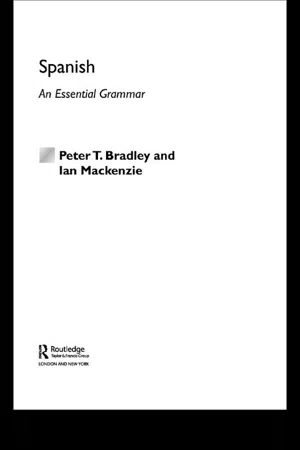Chapter 1
The alphabet, pronunciation, stress, spelling and punctuation
1.1 The alphabet
Due to recent changes, the composition of the Spanish alphabet today is more like English and other Romance languages. Because older reference works used a different system of classification, a few words of explanation may be helpful.
Until 1994, ch and ll were considered to be separate letters in the Spanish alphabet. Consequently, in dictionaries and word lists there were separate listings for words beginning with each of them, after c and l respectively. Likewise, this alphabetical order was observed when those letters occurred within words, with the result that cocha would be listed after all other words beginning with coc-, and callada after calzo. In 1994, under international pressure and the impact of computer sorting programs, the Association of Academies of Spanish adopted the internationally accepted standard of alphabetical order, no longer considering ch and ll to be separate letters. However, as a distinctive feature of the language, Spanish still considers ñ to be a separate letter. Dictionaries, therefore, still retain a separate listing for the few words beginning with ñ (after those beginning with n) and this order is preserved when ñ occurs within words (caña being listed after canzonetista).
1.2 Pronunciation
The only sure way of pronouncing Spanish correctly is to listen closely and try to imitate native speakers. However, a list of the Spanish letters together with their usual pronunciation is given in Table 1.1. This is offered as general guidance, drawing attention to instances where native speakers of English commonly make mistakes. Moreover, only the most important differences between Peninsular and Latin American Spanish are highlighted.
Table 1.1 The sounds of Spanish
1.3 Stress and written accents
The correct pronunciation of Spanish depends not only on being able to reproduce the correct sound for each letter, but on applying the correct emphasis to each syllable in individual words. Incorrect stress may mean that listeners have difficulty in understanding your meaning, and in some cases may even change the meaning of words.
1.3.1 Syllables: basic principles
For the purpose of identifying the syllables in Spanish words in order to understand stress and written accents, it is generally sufficient to know the following basic principles:
- syllables should end in a vowel as far as possible (so that a single consonant between vowels is attached to the vowel or vowels which follow it): ta-ba-co, po-pu-lar.
- combinations of consonants ending in -l or -r, as well as ch, cannot be split: a-pli-car, re-gre-so, ca-lle, cu-cha-ra.
- s does not belong to the same syllable as a following consonant: cas-ta- ña, pos-tre.
1.3.2 Stress: general principles
For purposes of identification only, stressed vowels are underlined.
1.3.2.1
When words end in a single vowel or the consonants n or s, the stress normally falls on the next to last syllable:
1.3.2.2
When words end in consonants other than n or s, the stress normally falls on the last syllable:
1.3.2.3
When words are stressed in ways that do not conform to the above rules, the stress is indicated by a written acute accent:
The correct use of the accent in Spanish is important, as a missing accent can completely change the meaning of a word: llego ‘I arrive’, llegó ‘he/she arrived’.
Written acute accents
1 A written acute accent on a syllable always indicates that the stress is located on that syllable.
2 Words which are stressed on syllables other than the last or next to the last will always require a written accent: enérgico, frívolo, válvula, miércoles.
3 Care is required when form...



